Kristen Elise's Blog, page 5
December 3, 2013
Most Over-Used Protagonists in Today's Novel Part III: The Porn Star
OK. So Fifty Shades of Grey sold fifteen gazillion copies. I get it. Sex sells, and we have known this ever since the first sexually reproducing hermaphroditic flatworms evolved out of an amoeba's binary fission gone wrong. But please understand something, dear reader (by which I actually mean, dear writer.) The fact that sex sells does NOT mean that writing porn is going to make you E.L. James. It won't, indeed.
To put a little bit of perspective on this "new" trend of writing porn disguised as literature, let's take a moment to review the evolution of porn.
In the beginning, there was Ron Jeremy....
Read the complete post at http://www.murderlab.com/2013/12/most...
To put a little bit of perspective on this "new" trend of writing porn disguised as literature, let's take a moment to review the evolution of porn.
In the beginning, there was Ron Jeremy....
Read the complete post at http://www.murderlab.com/2013/12/most...
A Tour Through the Cairo Egyptian Museum
It really is one of the "greatest historical treasures of the world." The Cairo Egyptian museum, or Museum of Egyptian Antiquities, is home to hundreds of thousands of artifacts excavated from the ancient sites around Cairo and throughout Egypt.
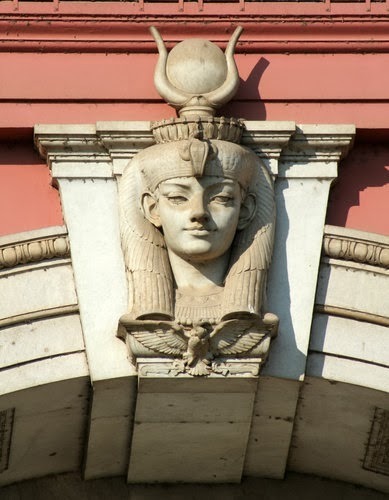 Cairo Egyptian Museum
Cairo Egyptian Museum
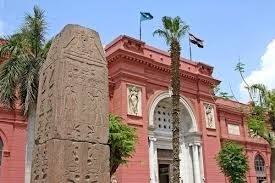 Egyptian Museum FacadeTourists flock to the funeral mask of King Tut and the vast collection of human mummies, two of which were, sadly, destroyed in 2011's Arab Spring.
Egyptian Museum FacadeTourists flock to the funeral mask of King Tut and the vast collection of human mummies, two of which were, sadly, destroyed in 2011's Arab Spring.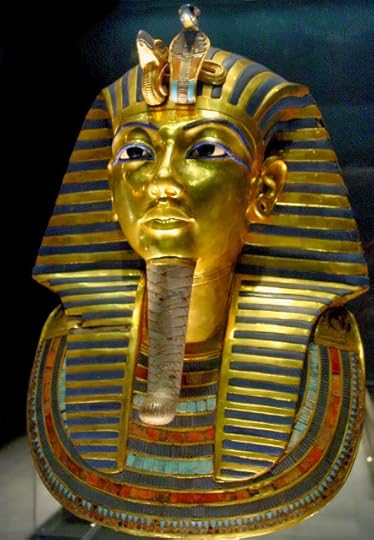 Tut Funeral Mask
Tut Funeral Mask
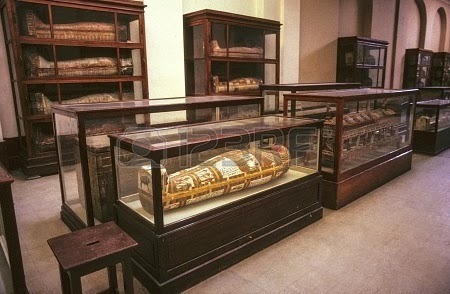 Human MummiesI, on the other hand, was more interested in the papyrus and coin rooms, the incredible Fayoum portraits and the tribute to mummified animals.
Human MummiesI, on the other hand, was more interested in the papyrus and coin rooms, the incredible Fayoum portraits and the tribute to mummified animals.Pictures are not allowed, and I had to check my camera at the door (along with my bag,) but I still had my iPhone. Below are the blurred shots I captured while looking out for security, along with some better pics of each pulled from Google Images.
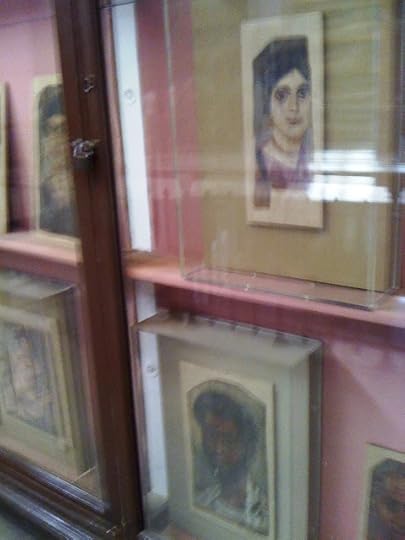 Fayoum Portraits Via iPhone
Fayoum Portraits Via iPhone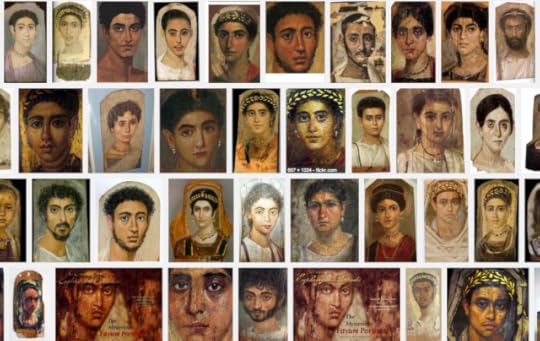 Fayoum Portraits Cairo Egyptian Museum
Fayoum Portraits Cairo Egyptian Museum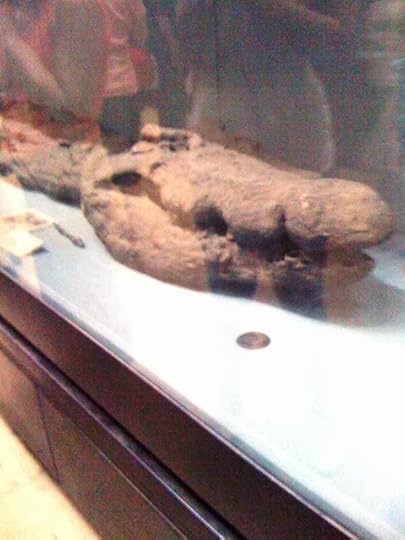 Mummified Croc Via iPhone
Mummified Croc Via iPhone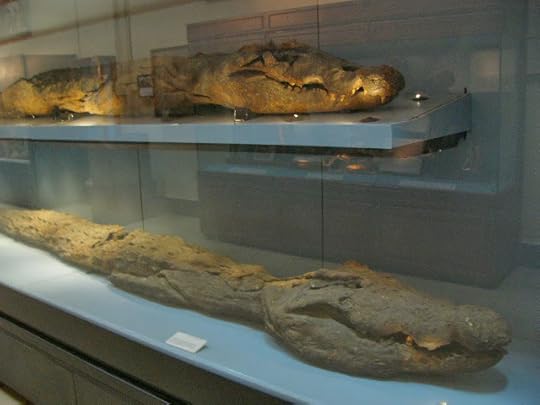 Mummified Crocs Cairo Egyptian Museum
Mummified Crocs Cairo Egyptian MuseumThe museum is poorly annotated and most of the signage is in Arabic, so it might be helpful to buy a guidebook before heading through. It's also not air-conditioned, and in the summer you'll find yourself surrounded by about ten thousand sweaty tourists. When you arrive, head to the gift shop on your left and pick up a guidebook. Then you go through metal detectors that beep every time someone passes through them, but the guards just wave everyone through anyway.
In The Vesuvius Isotope , protagonist Katrina Stone is forced to make a mad dash through the museum without ever getting to see the massive Greco-Roman area that she had set out for. She does, however, get to spend some quality time in the bathroom.
Protagonist Katrina Stone races through t he Museum of Egyptian Antiquities on her quest to solve Cleopatra's last riddle in The Vesuvius Isotope, a novel by Kristen Elise. Purchase The Vesuvius Isotope here.
Published on December 03, 2013 09:14
November 13, 2013
The *New* Great Library of Alexandria
Have you ever dreamed of wandering through the Great Library of Ancient Alexandria? Unrolling a papyrus scroll written by Cleopatra in one of the nine languages she spoke? Hob-knobbing with Aristotle in the world's first think tank?
Well, you can. Sort of.
Today's visitor to Alexandria, Egypt can visit the Bibliotheca Alexandrina, a modern-day recreation of the great library of the ancients. And this creation is definitely worth a visit. But for those who can't toddle off to Egypt this week, I offer here a photo tour instead.
One can spend an hour or more exploring the breathtaking architecture of the library. The building is modern and imposing, and it was designed to appear as if the library is sinking into the sea - a nod to the loss of its ancient counterpart. Indeed, one must cross a short bridge to access the library, passing by the "sinking" dome and approaching the tall structure.
 The Library at Alexandria, Egypt
The Library at Alexandria, Egypt
 Exterior Spires
Exterior Spires
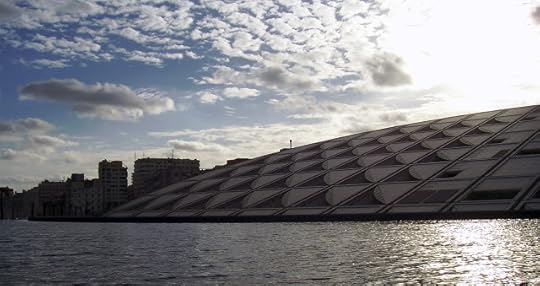 The Sinking Library
The Sinking Library
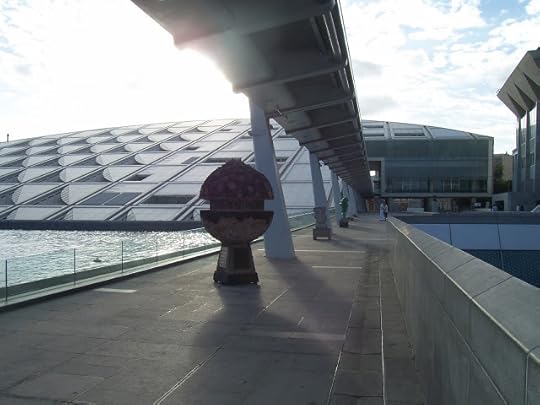 Waking Across the Bridge to the LibraryThe dome of the planetarium is prominently visible from the outside (although no photos were allowed from the inside!) Here we see the planetarium dome and the library's bust of Alexander the Great.
Waking Across the Bridge to the LibraryThe dome of the planetarium is prominently visible from the outside (although no photos were allowed from the inside!) Here we see the planetarium dome and the library's bust of Alexander the Great.
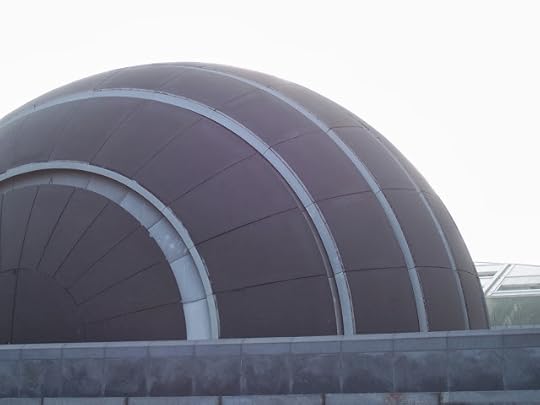 Planetarium of the Library
Planetarium of the Library
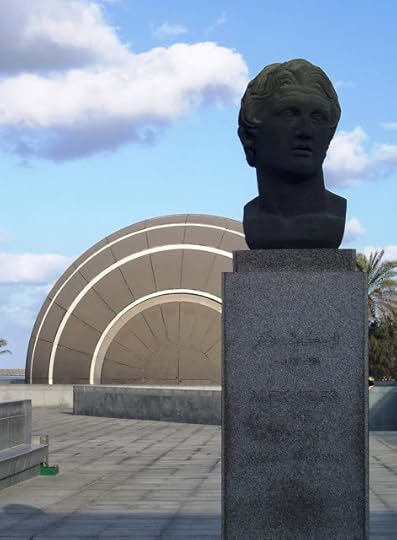 Bust of Alexander the Great with Planetarium DomeThe granite walls surrounding the library are inscribed in hundreds of languages. Even Cleopatra would have been awed! We see another tribute to literacy in the "big read" book bench, which happens to be open to a page written in Arabic on the left page and English on the right page. Within the library, the theme continues: one can find a manuscript museum and a legendary rare books collection. There is even a Nobel collection, dedicated exclusively to the works of Nobel laureates like our own Jeff Wilson.
Bust of Alexander the Great with Planetarium DomeThe granite walls surrounding the library are inscribed in hundreds of languages. Even Cleopatra would have been awed! We see another tribute to literacy in the "big read" book bench, which happens to be open to a page written in Arabic on the left page and English on the right page. Within the library, the theme continues: one can find a manuscript museum and a legendary rare books collection. There is even a Nobel collection, dedicated exclusively to the works of Nobel laureates like our own Jeff Wilson.



The library features several tributes to the science of the ancients, including a planetarium, a History of Science Museum, and this marble sundial (below.)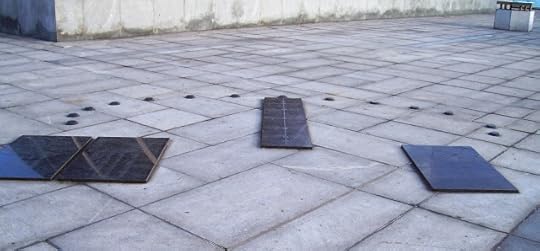 Marble Sundial
Marble Sundial
 Arabic and English Descriptions of Sundial
Arabic and English Descriptions of Sundial
 English Description of SundialThe interior of the library is bright and modern, taking advantage of the Mediterranean sun as a natural light source through a crystalline network of windows. The "library" is so much more than a library, featuring several art galleries, an IMAX theater, a museum of antiquities, an Alexandria and Mediterranean research center, and a center for Hellenistic studies, among many other resources.
English Description of SundialThe interior of the library is bright and modern, taking advantage of the Mediterranean sun as a natural light source through a crystalline network of windows. The "library" is so much more than a library, featuring several art galleries, an IMAX theater, a museum of antiquities, an Alexandria and Mediterranean research center, and a center for Hellenistic studies, among many other resources.
 Interior of the Library
Interior of the Library
 The Library at Dusk
The Library at Dusk
The ancient library of Alexandria, its modern counterpart, and a trail of clues in Alexandria lead protagonist Katrina Stone toward the answer to Cleopatra's last riddle in The Vesuvius Isotope, a novel by Kristen Elise. Purchase The Vesuvius Isotope here.
Well, you can. Sort of.
Today's visitor to Alexandria, Egypt can visit the Bibliotheca Alexandrina, a modern-day recreation of the great library of the ancients. And this creation is definitely worth a visit. But for those who can't toddle off to Egypt this week, I offer here a photo tour instead.
One can spend an hour or more exploring the breathtaking architecture of the library. The building is modern and imposing, and it was designed to appear as if the library is sinking into the sea - a nod to the loss of its ancient counterpart. Indeed, one must cross a short bridge to access the library, passing by the "sinking" dome and approaching the tall structure.
 The Library at Alexandria, Egypt
The Library at Alexandria, Egypt
 Exterior Spires
Exterior Spires
 The Sinking Library
The Sinking Library
 Waking Across the Bridge to the LibraryThe dome of the planetarium is prominently visible from the outside (although no photos were allowed from the inside!) Here we see the planetarium dome and the library's bust of Alexander the Great.
Waking Across the Bridge to the LibraryThe dome of the planetarium is prominently visible from the outside (although no photos were allowed from the inside!) Here we see the planetarium dome and the library's bust of Alexander the Great. Planetarium of the Library
Planetarium of the Library
 Bust of Alexander the Great with Planetarium DomeThe granite walls surrounding the library are inscribed in hundreds of languages. Even Cleopatra would have been awed! We see another tribute to literacy in the "big read" book bench, which happens to be open to a page written in Arabic on the left page and English on the right page. Within the library, the theme continues: one can find a manuscript museum and a legendary rare books collection. There is even a Nobel collection, dedicated exclusively to the works of Nobel laureates like our own Jeff Wilson.
Bust of Alexander the Great with Planetarium DomeThe granite walls surrounding the library are inscribed in hundreds of languages. Even Cleopatra would have been awed! We see another tribute to literacy in the "big read" book bench, which happens to be open to a page written in Arabic on the left page and English on the right page. Within the library, the theme continues: one can find a manuscript museum and a legendary rare books collection. There is even a Nobel collection, dedicated exclusively to the works of Nobel laureates like our own Jeff Wilson.


The library features several tributes to the science of the ancients, including a planetarium, a History of Science Museum, and this marble sundial (below.)
 Marble Sundial
Marble Sundial Arabic and English Descriptions of Sundial
Arabic and English Descriptions of Sundial
 English Description of SundialThe interior of the library is bright and modern, taking advantage of the Mediterranean sun as a natural light source through a crystalline network of windows. The "library" is so much more than a library, featuring several art galleries, an IMAX theater, a museum of antiquities, an Alexandria and Mediterranean research center, and a center for Hellenistic studies, among many other resources.
English Description of SundialThe interior of the library is bright and modern, taking advantage of the Mediterranean sun as a natural light source through a crystalline network of windows. The "library" is so much more than a library, featuring several art galleries, an IMAX theater, a museum of antiquities, an Alexandria and Mediterranean research center, and a center for Hellenistic studies, among many other resources.
 Interior of the Library
Interior of the Library
 The Library at Dusk
The Library at DuskThe ancient library of Alexandria, its modern counterpart, and a trail of clues in Alexandria lead protagonist Katrina Stone toward the answer to Cleopatra's last riddle in The Vesuvius Isotope, a novel by Kristen Elise. Purchase The Vesuvius Isotope here.
Published on November 13, 2013 10:26
October 31, 2013
The Night Before NaNo: A Halloween Poem for the Eve of NaNoWriMo
Twas the night before NaNo, when all through the house
Not a creature was stirring, except for my mouse.
The outlines were written and plotted with care,
In hopes that a massacre soon would be there.
The children were huddling, scared, in their beds,
With visions of Leatherface sawing off heads.
And mamma in her sweatpants and I in my socks,
Were just rousing our brains for a month with our Glocks.
When out on the lawn there arose such a clatter,
I sprang from the bed just to watch the blood splatter.
Away to the window I flew like a flash,
Tore open the shutters with a butcher knife's slash.
The moon in the cemetery from which I rave
Cast shadows of ghosts upon headstones and graves.
When, what to my horror, should appear through the fog,
But a skeletal carriage and eight demon dogs.
Read the rest at http://www.murderlab.com/2013/10/the-...
Not a creature was stirring, except for my mouse.
The outlines were written and plotted with care,
In hopes that a massacre soon would be there.
The children were huddling, scared, in their beds,
With visions of Leatherface sawing off heads.
And mamma in her sweatpants and I in my socks,
Were just rousing our brains for a month with our Glocks.
When out on the lawn there arose such a clatter,
I sprang from the bed just to watch the blood splatter.
Away to the window I flew like a flash,
Tore open the shutters with a butcher knife's slash.
The moon in the cemetery from which I rave
Cast shadows of ghosts upon headstones and graves.
When, what to my horror, should appear through the fog,
But a skeletal carriage and eight demon dogs.
Read the rest at http://www.murderlab.com/2013/10/the-...
Published on October 31, 2013 13:39
The Lighthouse, the Library, and the Caesarium of Alexandria, Egypt
 Reconstruction of the Lighthouse of Alexandria
Reconstruction of the Lighthouse of AlexandriaThe lighthouse of Alexandria, Egypt was one of the seven wonders of the ancient world. It was located at the tip of the island of Pharos, at the mouth of the Eastern Harbor of Alexandria. Detailed descriptions in ancient literature give us a complete picture of the library's architecture, size and scale.
 Fort Qaitbey, Alexandria fortress located at the site where the ancient lighthouse once stood
Fort Qaitbey, Alexandria fortress located at the site where the ancient lighthouse once stoodToday's visitor to Alexandria finds Fort Qaitbey instead, at the tip of the crescent-shaped island. From Midan Saad Zagloul, the square once dedicated to the offspring of Cleopatra, one can gaze across the harbor to the castle.
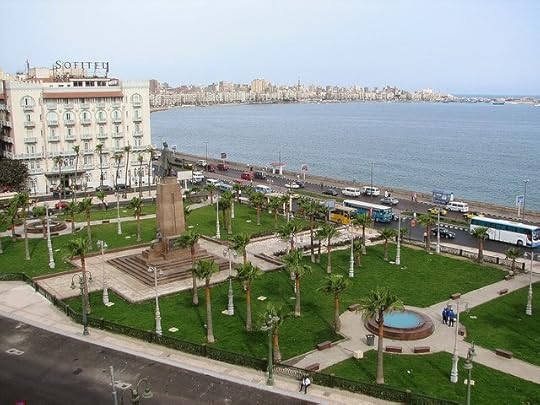 Midan Saad Zagloul
Midan Saad ZagloulA tribute to Cleopatra's patron goddess, Isis, still sits in Midan Saad Zagloul.
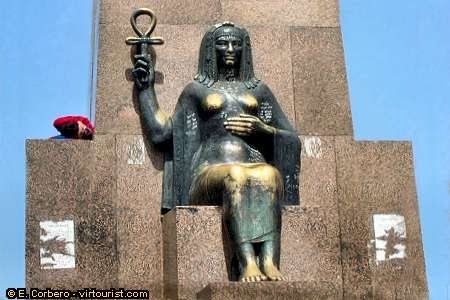 Statue of Isis in Midan Saad Zagloul.
Statue of Isis in Midan Saad Zagloul.Photo credit: Virtual TouristUnlike the lighthouse, we know very little of the architecture of the legendary Great Library of Alexandria. Today, a visitor to Alexandria can visit the Bibliotheca Alexandrina, a modern library designed to appear as if it is sinking into the sea - a tribute to the loss of the ancient library and its thousands upon thousands of stolen books.
 The New Library of Alexandria
The New Library of Alexandria
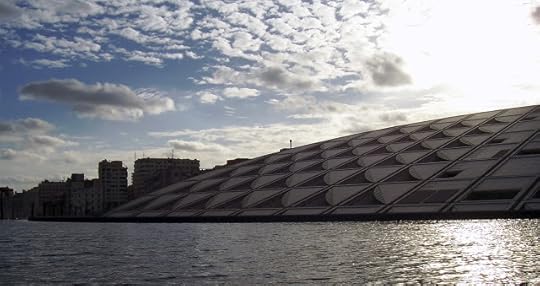 The Library Slipping into the Sea
I glanced out again at Fort Qaitbay, and then I turned to look behind me at the square. Beyond it were modern buildings, buildings that had been erected where the ancient library of Alexandria once stood. The lighthouse would have been visible from the library, and vice versa.
The Library Slipping into the Sea
I glanced out again at Fort Qaitbay, and then I turned to look behind me at the square. Beyond it were modern buildings, buildings that had been erected where the ancient library of Alexandria once stood. The lighthouse would have been visible from the library, and vice versa.
The lighthouse. The library. The Caesarium. All three lost to time.
But in my mind, the three ancient monuments appeared before me in all their grandeur, and I felt a chill through the warm Mediterranean air. Because I suddenly knew what I needed to do.
“I’m sorry, Jeff,” I said aloud.
I stepped across the square and into a pharmacy, where I purchased a bottle of sleeping pills.
-Excerpt from The Vesuvius Isotope, a novel by Kristen Elise. Purchase The Vesuvius Isotope here.
Published on October 31, 2013 10:15
October 23, 2013
New Central Library, Downtown San Diego
 Library exterior with domeThe eagerly anticipated moment has finally arrived! Months after the old Central Library was shut down in the ghetto, the new library has re-opened in a new ghetto! But seriously, folks, don't be intimidated by your surroundings. Once you get past the front doors, the new library is awesome. I highly recommend checking it out (and while you're there, check out
The Vesuvius Isotope
...which should be on the shelves by now!)
Library exterior with domeThe eagerly anticipated moment has finally arrived! Months after the old Central Library was shut down in the ghetto, the new library has re-opened in a new ghetto! But seriously, folks, don't be intimidated by your surroundings. Once you get past the front doors, the new library is awesome. I highly recommend checking it out (and while you're there, check out
The Vesuvius Isotope
...which should be on the shelves by now!)So what makes this place so great? For one thing, it is nine stories high and filled with resources. Here's a much abbreviated summary of what they are:
First floor:
350-seat state-of-the-art theater
Garden courtyard
East arcade "reading nooks"
Library shop
Conference center
Video wall
Lobby
Friends of the Library Used Bookstore
Branch library for downtown residents (library within the library)
Elevator art
Resources for customers with disabilities (Braille, etc.)
Children's library
Second floor:
Teen center
Homework center
Health and wellness information center
Business, science, and industry collection
Social science collection
Third floor:
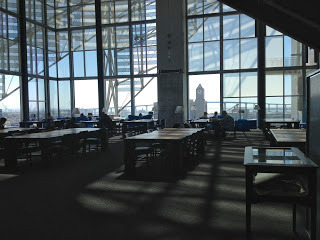 8th floor open-air reading room
8th floor open-air reading roomPatent and trademark resource center
Government documents
Newspapers and periodicals
Fourth floor:
Computer lab and computer training center
Multi-media studio and training center
Wall art
Literature collection
Fifth floor:
Career center
Rock garden
History collection
Sixth and seventh floors:
Onsite civic high school (I'm not kidding: there's a school inside the library)
Eighth floor:
Open-air reading room offering views of downtown San Diego and the Coronado bridge
Literacy services (READ San Diego)
IDEA (Innovation and digital expression activity) lab
Baseball research center (sort of a museum for the Padres)
Art, music, and recreation collection
Ninth floor:
Special collections
Rare book room
Art gallery
Sculpture garden
Rooftop terraces
Special events suite with catering kitchen
In addition to all of that, the library is jam-packed with little reading nooks and windows, meeting rooms, and computer resources. There is a 250-space parking lot beneath the library and easy public transit accessibility. Supporters of the library have the opportunity to purchase a brick, which will then be displayed with your personalized message for all to see!
Published on October 23, 2013 10:08
October 22, 2013
South on the Horizon: Lance Charnes' Follow-Up to Doha 12
Lance Charnes' debut thriller, Doha 12, is a "High Quality, Compelling Thriller. Terrific Reading!" Today, Lance's highly anticipated second novel is on the horizon. Here we reveal the details of South. For more information, visit the South website. See an interview with Lance here.
SOUTH
by Lance Charnes
Luis Ojeda owes his life to the Pacifico Norte cartel. Literally. Now it’s time to pay.
Luis led escaping Muslims out of the U.S. during the ten years following a 2019 terrorist attack on Chicago. He retired after nearly being killed by a border guard. But now in 2032, the Nortes give Luis a choice: pay back the fortune they spent saving his life, or take on a special job.
More at http://www.murderlab.com/2013/10/sout...
Doha 12
Lance Charnes
SOUTH
by Lance Charnes
Luis Ojeda owes his life to the Pacifico Norte cartel. Literally. Now it’s time to pay.
Luis led escaping Muslims out of the U.S. during the ten years following a 2019 terrorist attack on Chicago. He retired after nearly being killed by a border guard. But now in 2032, the Nortes give Luis a choice: pay back the fortune they spent saving his life, or take on a special job.
More at http://www.murderlab.com/2013/10/sout...
Doha 12
Lance Charnes
October 21, 2013
Trust, Treachery and the Caduceus
Today I'm guest posting on www.florenceinferno.com - a site dedicated to Dan Brown's latest, with a post about the symbolism of the caduceus in Inferno. Check it out...here...
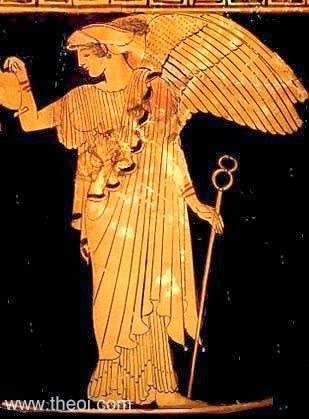

Published on October 21, 2013 10:48
October 17, 2013
Murder in the Spa
I've just found the location for the opening scene of my third thriller. No, I'm not kidding.
Who opens a thriller with a scene at a spa? This girl, I suppose. And I suppose that shouldn't be a surprise, given that my last novel, through no conscious choice of my own, ended up opening on a nude beach. It's funny how settings (and characters, for that matter) just barge right in and novel-bomb one's latest piece of writing without even so much as an introductory handshake.
This time, it's the spa. Specifically, it's the Spa: The one around which the town of Spa, Belgium sprang up (pun fully intended.) The one from which all other spas take their universal nomenclature.
 The word "spa" is thought to descend, as so many things do, from ancient Rome. These healing waters in the mountains of Belgium, once visited by the likes of Pliny the Elder, birthed the Latin phrase Sanus Per Aquam, meaning "health through water." How lovely. Follow the acronym and you get the word "SPA."
The word "spa" is thought to descend, as so many things do, from ancient Rome. These healing waters in the mountains of Belgium, once visited by the likes of Pliny the Elder, birthed the Latin phrase Sanus Per Aquam, meaning "health through water." How lovely. Follow the acronym and you get the word "SPA."Other famous visitors to these therapeutic springs included Peter the Great, Charles II, and everyone's favorite head-hunter, Henry VIII. The natural elixir bursting forth from the underground here is rich in calcium, sodium, magnesium, iron, and bicarbonate (a.k.a. baking soda.) So its healing properties are not a myth: we realize today that each of these minerals is essential.
Indeed, from their discovery in Roman times, to the development of the city of Spa in the 15th century, to today, these waters are where people go to detox and rejuvenate. They are recommended for anemia, cardiovascular diseases, respiratory disorders, rheumatism, gynecological disorders, mental fatigue and stress. And they always have been.
Perhaps Henry VIII should have spent more time here.
 So what does all of this have to do with a thriller? Well, I'm sure you can imagine all sorts of possibilities. Drowning in the mineral baths (duh). Strangulation during an overzealous deep tissue massage. Being thrown from the top of the mountain or a drop of arsenic in your mineral water. But you'd be dead wrong.
So what does all of this have to do with a thriller? Well, I'm sure you can imagine all sorts of possibilities. Drowning in the mineral baths (duh). Strangulation during an overzealous deep tissue massage. Being thrown from the top of the mountain or a drop of arsenic in your mineral water. But you'd be dead wrong.You see, the protagonist of The Queenmakers is a healer. Having recently discovered The Vesuvius Isotope, Katrina Stone has now built a pharmaceutical empire around the therapeutic properties of natural elements. And so, in pursuit of science and medicine, she must visit the spa of Spa.
Ah, the hardships of field research.
Reposted from Novel Travelist.
The Queenmakers is the forth-coming sequel to The Vesuvius Isotope. Look for it in Fall 2014.
Buy The Vesuvius Isotope on Amazon.
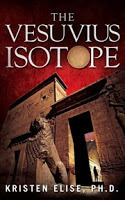
When her Nobel laureate husband is murdered, biologist Katrina Stone can no longer ignore the secrecy that increasingly pervaded his behavior in recent weeks. Her search for answers leads to a two-thousand-year-old medical mystery and the esoteric life of one of history’s most enigmatic women. Following the trail forged by her late husband, Katrina must separate truth from legend as she chases medicine from ancient Italy and Egypt to a clandestine modern-day war. Her quest will reveal a legacy of greed and murder and resurrect an ancient plague, introducing it into the twenty-first century.
Kristen Elise, Ph.D. is a drug discovery biologist and the author of The Vesuvius Isotope. She lives in San Diego, California, with her husband, stepson, and three canine children.
Published on October 17, 2013 16:05
What a Difference a Snake Makes: The Caduceus Versus the Rod of Asclepius
 Rod of AsclepiusThe confusion between the caduceus and the Rod of Asclepius is suddenly all the rage.
Rod of AsclepiusThe confusion between the caduceus and the Rod of Asclepius is suddenly all the rage.In Dan Brown’s Inferno, Robert Langdon clarifies the distinction between the two symbols to World Health Organization director Elizabeth Sinskey. In The Vesuvius Isotope, we follow the caduceus from Paris to ancient Egypt. Here, we begin in ancient Greece.
Asclepius was the Greek god of medicine, and he held a rod that bore one snake. This snake winds around a Rod of Asclepius asymmetrically, and there are no wings.
There are two hypotheses as to where the rod of Asclepius came from and how it became associated with medicine. One is the 'worm theory,' which dates to the Ebers papyrus (~1500 B.C.E,) one of the first ancient Egyptian medical documents. The Ebers papyrus describes a treatment for worms. The emerging end of the worm is to be wrapped around the end of a staff and the staff wound until the worm is removed, like a big fish is reeled in on a fishing rod. This technique is still used today.
The other hypothesis dates to the Bible. In Biblical Lore, Moses carried a bronze staff, around which a bronze serpent was wound. Anyone bit by a serpent need only look at the staff to be healed of the snake's venom. This particular medical technique, I’m fairly certain, is not in practice today.
 Caduceus
CaduceusIn contrast, the caduceus is a symmetrical staff with wings and two snakes. The common dogma claims that confusion between the two symbols is what led to the association of the caduceus with medicine. The common dogma also claims that the caduceus symbol first appeared as a medical symbol in the 15th century, when a Swiss medical printer used it as his printer’s vignette.
I happen to believe that all of this is a crock.
This story maintains that, like the Rod of Asclepius, the caduceus hails from ancient Greece. It is thought to have originated with Iris, the messenger of Hera. Yet, this association of the caduceus with Iris and then with medicine is actually quite ironic—because Iris, while frequently referred to as messenger, was actually more like Hera’s hit woman. In Greek mythology, Iris carried a vessel filled with water from the River Styx. And at Hera’s request, she used this ancient elixir—an ancient pharmaceutical, if you will—to put liars to sleep.
In later myths, the caduceus also became associated with Hermes, which brought the connotations of treachery and deception along with Hera's connotation with death.
So we see that our so-called ‘Greek’ medical symbol was in fact more like a skull and crossbones in ancient Greek mythology. To find the caduceus in medicine, on the other hand, we must travel instead to ancient Egypt, where Isis—the ancient Egyptian Goddess of medicine—brings wings and snakes to a vertical staff.
But first, we go to Paris. We enter the Louvre and descend into the Egyptian rooms, and we are immediately drawn to the sarcophagus of Pharaoh Ramses III. On this sarcophagus, dating to approximately 1150 B.C.E., is a large, winged Goddess Isis.
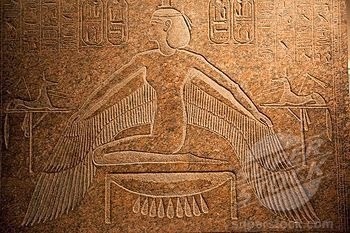 Winged Isis on the Sarcophagus of Ramses III, ca. 1150 B.C.EThe Egyptians liked to incorporate Isis in their burial chambers because they believed in resurrection, and Isis brought life. To an imaginative eye (or to one who works in the medical field and sees a caduceus in everything,) the Isis depicted on this tomb may resemble a caduceus.
Winged Isis on the Sarcophagus of Ramses III, ca. 1150 B.C.EThe Egyptians liked to incorporate Isis in their burial chambers because they believed in resurrection, and Isis brought life. To an imaginative eye (or to one who works in the medical field and sees a caduceus in everything,) the Isis depicted on this tomb may resemble a caduceus.Not convinced? That's OK. Me neither.
We now travel to Aswan, Egypt, to the largest Temple of Isis of the ancient world. It is on the island of Philae, and the temple is the single, massive feature adorning the entire tiny island.
We progress into increasingly smaller and darker rooms until we are led by birds and more birds into the inner sanctuary. Look at the birds—do they remind you of anything? Me too.
As we progress deeper and deeper into its depths, we realize why this place is called a sanctuary. The temperature drops abruptly, and we at last feel a life-giving breeze, relief from the merciless Egyptian sun.
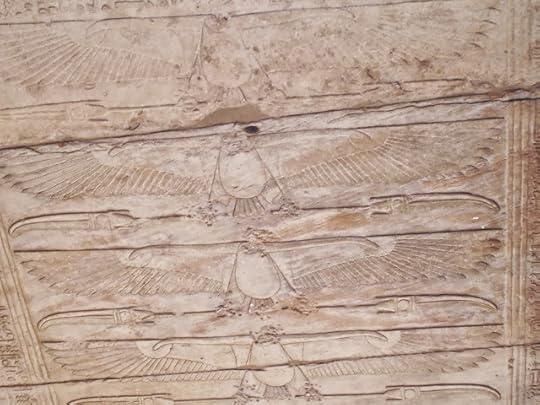 Birds Leading into the Inner SanctuaryPerhaps it is not coincidence that Isis' powers of healing hail from the legend that she used her wings to breathe life into the dead Osiris, wings which—for reasons passing my understanding—are rarely depicted on the Goddess Isis in Egypt or elsewhere in the world. Normally, she looks like this:
Birds Leading into the Inner SanctuaryPerhaps it is not coincidence that Isis' powers of healing hail from the legend that she used her wings to breathe life into the dead Osiris, wings which—for reasons passing my understanding—are rarely depicted on the Goddess Isis in Egypt or elsewhere in the world. Normally, she looks like this: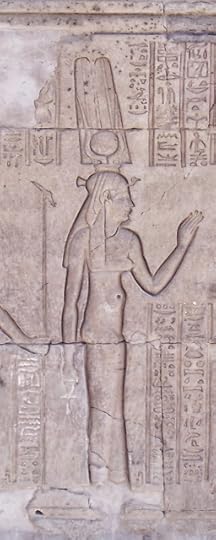 Normal IsisSometimes Isis carries a staff, and sometimes an ankh (as in this photo.) She almost always has the Horns of Hathor and the sun disk on her head (as in this photo.) And she almost always has a snake somewhere affixed, typically on her head (as in this photo.)
Normal IsisSometimes Isis carries a staff, and sometimes an ankh (as in this photo.) She almost always has the Horns of Hathor and the sun disk on her head (as in this photo.) And she almost always has a snake somewhere affixed, typically on her head (as in this photo.)She always wears a sheath dress (as in this photo.) And she never, ever has wings.
Why?
Why would the Goddess Isis, whose powers of healing were born from her wings, be forever depicted without them? It is from this question that the hypothesis arises: the winged Isis, specifically, is the healer.
So imagine our surprise when we follow those birds, as if fluttering in on the life-giving breeze their wings provide, into the cool, dark, inner sanctuary at the Temple of Isis at Philae.
And in the inner sanctuary of this temple we find a rare example of the winged Isis in ancient Egypt.
On Isis' head are the Horns of Hathor, and protruding from her forehead is the typical snake. The wingspan of Isis is embracing her son Horus, who holds a vertical staff.
Across from Isis stands another figure, also adorned with snakes. And between them stands a bouquet of the lotus and papyrus, symbols of Upper and Lower Egypt.
Is it any wonder that our modern medical symbol would come to be a winged staff with snakes? And, which goddess is the most likely representative of this symbol: the ancient Egyptian Goddess Isis, or the Greek Iris, the Angel of Death?
The caduceus may not have appeared on that Swiss printer's vignette until the 1500s, but Isis was referred to as a "woman doctor"—more than once— in the Ebers papyrus (~1500 B.C.E.) Yes, the very same ancient medical document that gave us the Rod of Ascelpius.
Oh Isis, thou great enchantress, heal me, deliver me from all evil, bad, typhonic things, from demoniacal and deadly diseases and pollutions of all sorts that rush upon me, as thou didst deliver and release thy son Horus!
-The Ebers Papyrus, ca. 1500 BCE
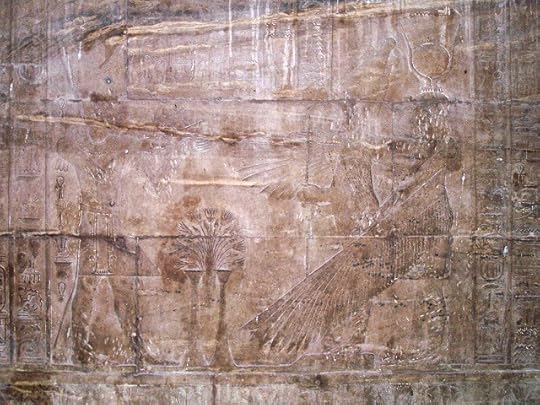 Actual image of Winged Isis in Inner Sanctuary, Temple of Isis, Aswan, Egypt
Actual image of Winged Isis in Inner Sanctuary, Temple of Isis, Aswan, Egypt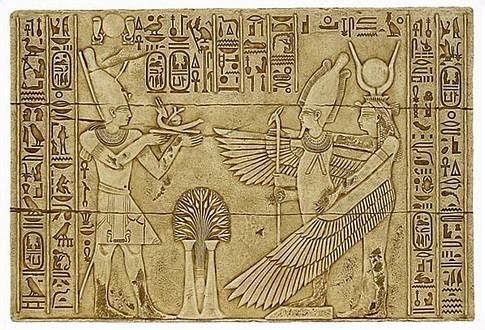 Recreation of Winged Isis in Inner Sanctuary, Temple of Isis, Aswan, Egypt
Recreation of Winged Isis in Inner Sanctuary, Temple of Isis, Aswan, Egypt
Published on October 17, 2013 13:28



